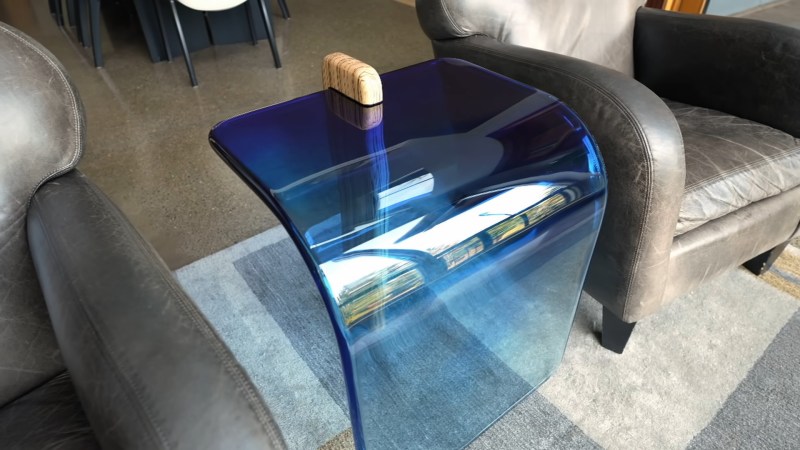Epoxy resins have been used to make some pretty cool furniture, but since it’s still a relatively new material, makers are still discovering new techniques to work with resin. [Cam] from Blacktail Studio may be the first person to bend fully cured epoxy using nothing but a form and the power of the sun.
Inspired by a friend’s mishap with an epoxy table left out in the sun too long, [Cam] wanted to see if he could purposely bend an epoxy sheet into an interesting shape. The tabletop was poured in sections to give an ombre look before being planed and given a preliminary surface finish. The epoxy sheet was then clamped onto a form made of kerfed plywood and left in direct sunlight on a 104°F (40°C) day. Once the sheet began to deform in the sunlight, ratchet straps and more clamps were added to conform the sheet to the bending form.
After letting the tabletop relax for a few days, [Cam] finished the surface with lots of sanding and an automotive polishing regimen. The epoxy was then attached to a single zebrawood leg to give a very modern-looking, waterfall-esque table.
More interesting projects with resin you might want to check out are this ocean-themed epoxy nightlight, how to degas epoxy on the cheap, or some techniques for cold casting with resin.

















This technique is well known in the composite aircraft and boat building area.
Epoxy can gain strength with “post curing”, heating the epoxy after it cures. People will wrap structures in black garbage bags and put them in the sun to get a little heat into large structures.
Too much heat though, and gravity will wreck the part.
Indeed. Never seen this approach before though, surprised it worked so well on such a thick ‘fully’ cured casting. Another thing to consider.
“how to degas epoxy on the cheap”
TBH, I wondered how epoxy could take on characteristics of the artist Degas.
B^)
So does the UV from the Sun warp it or just the heat? If it’s just the heat you could do the same in a hot tub really.
It’s the temperature that does this.
At 11:15 he measured the epoxy to be 57°C, and he did it over the course of a full day, under significant pressure from the clamps and ratchet straps (so this is probably near the lower limit for temperature)
You could do it in a hot tub (assuming there’s no safety limiting the temps), but keeping a tub at that temperature for a whole day is going to take a significant amount of energy. The sun is free and using it to heat things up has no environmental impact.
True the sun is free but it wouldn’t really work at night or in the winter. Still this is an interesting technique.
We’ve come a long way since pulling such “art” out of a house fire.
I love ❤️ this table. The zebra wood is the perfect touch for the table. I love that you are willing to take a chance; that’s the sign of a true artist.
I don’t like it. About half the table is designed to get your coffee into the rug. Not a nice feature.
Just don’t turn up the heating too much in your house….
I’d think after this process you could likely get damn close to boiling water from the ambient heat before it changes anything in the slab again – but there are so very many variables in resin work nothing is universally certain, may take a greater post cure heat cycle etc.
I use a lot of epoxy in making high-power model rockets. As suggested above by Tom Brusehaver, most epoxies do not fully cure at room temperature. Post-cure heating improves strength and heat resistance. Ideally the most effective temperatures for post-cure are above the glass transition temperature, typically ca. 150C for several hours at least. Lower temperatures are still somewhat helpful, though.
It would be interesting to determine how well the solar technique would work if the object being bent was properly post-cured. Then again, since you *want* the object to bend…why even bother with post-cure?
Before the bend it doesn’t make a lot of sense, but maybe doing a post-cure after the bend would help with retaining the shape.
Beautiful looking table, and very cool technique, but when your guest places their beer just a little to close to the front, it will be obvious that the design goes beyond “impractical” to “negative practicality”.
This table is absolutely beautiful I love it!
Love this Table I would call it Zebra Blue Falls or Crystal Blue Persuasion
I would love to have this table.